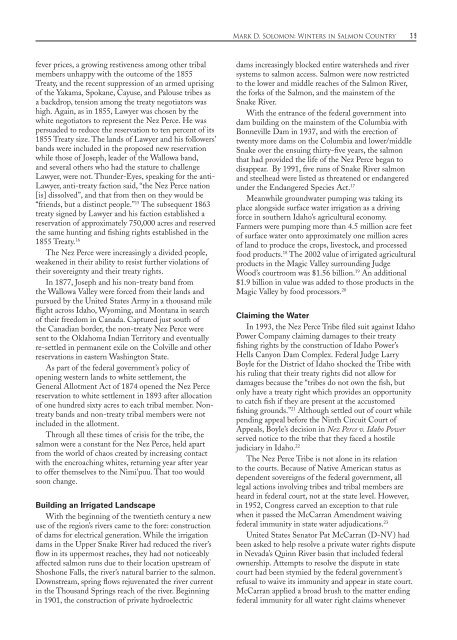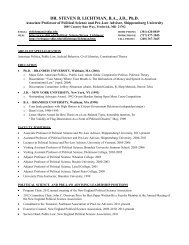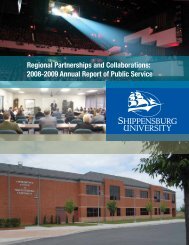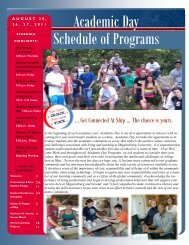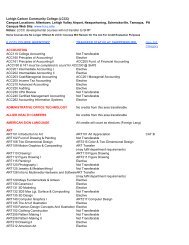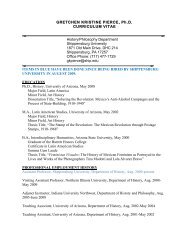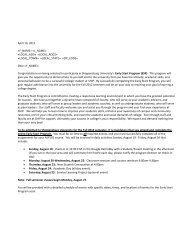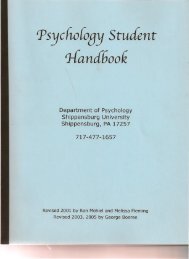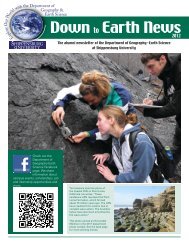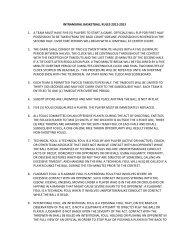Complete Issue - Shippensburg University
Complete Issue - Shippensburg University
Complete Issue - Shippensburg University
- No tags were found...
Create successful ePaper yourself
Turn your PDF publications into a flip-book with our unique Google optimized e-Paper software.
Mark D. Solomon: Winters in Salmon Country 39fever prices, a growing restiveness among other tribalmembers unhappy with the outcome of the 1855Treaty, and the recent suppression of an armed uprisingof the Yakama, Spokane, Cayuse, and Palouse tribes asa backdrop, tension among the treaty negotiators washigh. Again, as in 1855, Lawyer was chosen by thewhite negotiators to represent the Nez Perce. He waspersuaded to reduce the reservation to ten percent of its1855 Treaty size. The lands of Lawyer and his followers’bands were included in the proposed new reservationwhile those of Joseph, leader of the Wallowa band,and several others who had the stature to challengeLawyer, were not. Thunder-Eyes, speaking for the anti-Lawyer, anti-treaty faction said, “the Nez Perce nation[is] dissolved”, and that from then on they would be“friends, but a distinct people.” 15 The subsequent 1863treaty signed by Lawyer and his faction established areservation of approximately 750,000 acres and reservedthe same hunting and fishing rights established in the1855 Treaty. 16The Nez Perce were increasingly a divided people,weakened in their ability to resist further violations oftheir sovereignty and their treaty rights.In 1877, Joseph and his non-treaty band fromthe Wallowa Valley were forced from their lands andpursued by the United States Army in a thousand mileflight across Idaho, Wyoming, and Montana in searchof their freedom in Canada. Captured just south ofthe Canadian border, the non-treaty Nez Perce weresent to the Oklahoma Indian Territory and eventuallyre-settled in permanent exile on the Colville and otherreservations in eastern Washington State.As part of the federal government’s policy ofopening western lands to white settlement, theGeneral Allotment Act of 1874 opened the Nez Percereservation to white settlement in 1893 after allocationof one hundred sixty acres to each tribal member. Nontreatybands and non-treaty tribal members were notincluded in the allotment.Through all these times of crisis for the tribe, thesalmon were a constant for the Nez Perce, held apartfrom the world of chaos created by increasing contactwith the encroaching whites, returning year after yearto offer themselves to the Nimi’puu. That too wouldsoon change.Building an Irrigated LandscapeWith the beginning of the twentieth century a newuse of the region’s rivers came to the fore: constructionof dams for electrical generation. While the irrigationdams in the Upper Snake River had reduced the river’sflow in its uppermost reaches, they had not noticeablyaffected salmon runs due to their location upstream ofShoshone Falls, the river’s natural barrier to the salmon.Downstream, spring flows rejuvenated the river currentin the Thousand Springs reach of the river. Beginningin 1901, the construction of private hydroelectricdams increasingly blocked entire watersheds and riversystems to salmon access. Salmon were now restrictedto the lower and middle reaches of the Salmon River,the forks of the Salmon, and the mainstem of theSnake River.With the entrance of the federal government intodam building on the mainstem of the Columbia withBonneville Dam in 1937, and with the erection oftwenty more dams on the Columbia and lower/middleSnake over the ensuing thirty-five years, the salmonthat had provided the life of the Nez Perce began todisappear. By 1991, five runs of Snake River salmonand steelhead were listed as threatened or endangeredunder the Endangered Species Act. 17Meanwhile groundwater pumping was taking itsplace alongside surface water irrigation as a drivingforce in southern Idaho’s agricultural economy.Farmers were pumping more than 4.5 million acre feetof surface water onto approximately one million acresof land to produce the crops, livestock, and processedfood products. 18 The 2002 value of irrigated agriculturalproducts in the Magic Valley surrounding JudgeWood’s courtroom was $1.56 billion. 19 An additional$1.9 billion in value was added to those products in theMagic Valley by food processors. 20Claiming the WaterIn 1993, the Nez Perce Tribe filed suit against IdahoPower Company claiming damages to their treatyfishing rights by the construction of Idaho Power’sHells Canyon Dam Complex. Federal Judge LarryBoyle for the District of Idaho shocked the Tribe withhis ruling that their treaty rights did not allow fordamages because the “tribes do not own the fish, butonly have a treaty right which provides an opportunityto catch fish if they are present at the accustomedfishing grounds.” 21 Although settled out of court whilepending appeal before the Ninth Circuit Court ofAppeals, Boyle’s decision in Nez Perce v. Idaho Powerserved notice to the tribe that they faced a hostilejudiciary in Idaho. 22The Nez Perce Tribe is not alone in its relationto the courts. Because of Native American status asdependent sovereigns of the federal government, alllegal actions involving tribes and tribal members areheard in federal court, not at the state level. However,in 1952, Congress carved an exception to that rulewhen it passed the McCarran Amendment waivingfederal immunity in state water adjudications. 23United States Senator Pat McCarran (D-NV) hadbeen asked to help resolve a private water rights disputein Nevada’s Quinn River basin that included federalownership. Attempts to resolve the dispute in statecourt had been stymied by the federal government’srefusal to waive its immunity and appear in state court.McCarran applied a broad brush to the matter endingfederal immunity for all water right claims whenever


